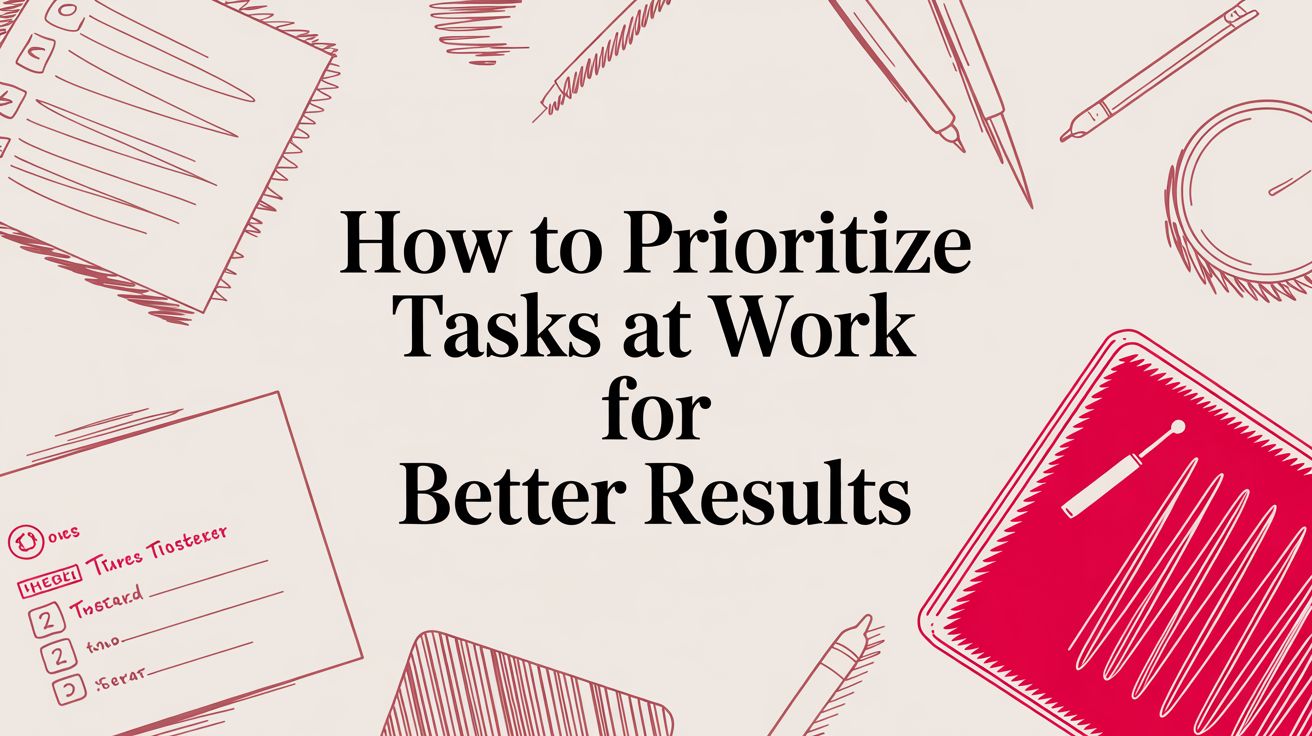To really get a handle on your time, you have to move from just reacting to your day to intentionally designing it. This usually involves three key phases: first, figuring out where your time is actually going, then zeroing in on high-impact tasks, and finally, building a real schedule using a technique like time blocking.
Why Being Busy Is Hurting Your Productivity
It’s easy to confuse being busy with being productive, but they’re worlds apart. Busyness is all about motion; productivity is all about results. So many of us get stuck in a loop of constant activity—clearing the inbox, jumping from meeting to meeting, and swatting away notifications—without ever touching the work that truly matters. This is the hidden trap of poor time management.
This “work about work” doesn’t just eat up your schedule. It saps your focus and mental energy. Every time a notification pings, it yanks you out of deep work, and research shows it can take over 20 minutes to get back into that focused state. This constant context-switching is a massive productivity drain, leaving you feeling wiped out by the end of the day with very little to show for it. To break this cycle, you have to learn how to stay focused at work and boost productivity.
The Real Consequences of Inefficient Work Habits
The fallout from inefficient habits goes way beyond a messy to-do list. When you don’t manage your time well, stress climbs, deadlines slip, and the quality of your work takes a nosedive. This creates a ripple effect that can damage your professional reputation and, more importantly, your personal well-being.
The constant feeling of being behind can quickly lead to burnout, a state of complete emotional and physical exhaustion that makes it nearly impossible to perform. This isn’t just a personal problem; it has staggering economic consequences.
In fact, Gallup’s research connects a mind-blowing $8.8 trillion in lost productivity directly to employee disengagement and burnout. That’s about 9% of the entire world’s GDP. This really drives home the point that better time management isn’t just a “nice-to-have” skill; it’s essential for creating a work culture that values focus and well-being.
The flexibility of remote work can make these challenges even tougher, which is why structured time management is so critical. If you’re considering making the switch, our guide on how to find remote work can help you start off on the right foot.
Ultimately, mastering your time means taking back control. It’s about making sure your energy is aimed at the things that deliver real value, which is a win for both your career and your mental health. Once you grasp the true cost of inefficiency, you have all the motivation you need to build the skills to thrive.
Prioritize Tasks That Actually Matter

Let’s be honest, a massive to-do list usually just means you’re busy. It doesn’t mean you’re being productive. Real progress happens when you know exactly what to tackle first, separating the work that actually matters from all the urgent-but-unimportant noise that clogs up your day.
This is where you move beyond a simple checklist and start using a structured approach to prioritization. With a solid framework, you can confidently decide where to spend your energy to get the biggest returns. One of the best and most straightforward methods I’ve come across is the Eisenhower Matrix.
Use the Eisenhower Matrix to Clarify Your Day
Think of the Eisenhower Matrix as a simple but powerful tool for sorting your tasks. It helps you categorize everything on your plate based on two simple factors: its urgency and its importance. This grid gives you a crystal-clear visual of your workload, so you can allocate your time and energy way more effectively.
Every single task can be dropped into one of four boxes:
- Urgent & Important (Do First): These are the fires you have to put out now. Think a client crisis or a hard project deadline that’s due today. They get your immediate and undivided attention.
- Not Urgent & Important (Schedule): This is where your future success is built. We’re talking about strategic planning, learning new skills, or building key relationships. You have to be proactive and block out time for these, or they’ll eventually turn into urgent problems.
- Urgent & Not Important (Delegate): These are the sneaky distractions that feel important but aren’t. This could be certain emails, minor requests from colleagues, or meetings you don’t really need to be in. If you can delegate them, do it.
- Not Urgent & Not Important (Eliminate): This quadrant is for all the time-wasters that provide zero real value. Mindlessly scrolling through social media is a classic example, but it can be any task that doesn’t move you closer to your goals.
It’s fascinating how people approach this. A recent survey from Flowlu on productivity habits found a huge gap. While a tiny 1% of people fully use a system like the Eisenhower Matrix, a whopping 92% use bits and pieces of it, like making basic to-do lists. Imagine the jump in productivity if more people adopted the full, structured system.
Choose Your Prioritization Framework
The Eisenhower Matrix is a fantastic starting point, but it’s not the only game in town. Depending on your job or the type of projects you handle, another method might be a better fit. It’s worth exploring a few to see what clicks with your workflow.
Here’s a quick rundown of some popular prioritization frameworks to help you find one that works for you.
Choosing Your Prioritization Framework
| Technique | Best For | Key Principle |
|---|---|---|
| Eisenhower Matrix | Daily and weekly individual task planning. | Separating tasks by urgency and importance to identify what to do, schedule, delegate, or delete. |
| MoSCoW Method | Project management and team collaboration. | Categorizing tasks as Must-have, Should-have, Could-have, or Won’t-have to align stakeholder expectations. |
| ABCDE Method | Action-oriented individuals with long task lists. | Assigning a letter value (A-E) to each task based on its consequence to determine its priority level. |
The MoSCoW method, for instance, is a lifesaver for team projects where you absolutely need everyone aligned on what the core deliverables are.
The goal isn’t to rigidly follow one method forever. The real skill is in using these frameworks to build the habit of constantly asking, “Is this the most valuable use of my time right now?”
This mindset is crucial, especially when new tasks pop up. Instead of just tacking a new request onto your list, take a moment to run it through your chosen framework. Where does it really fit in?
Learning to communicate your focus and manage expectations is a non-negotiable skill, and it’s one of the most important remote work best practices for staying productive without burning out. When you master prioritization, your to-do list stops being a source of anxiety and becomes what it should be: a clear roadmap for getting things done.
Using Time Blocking to Design Your Ideal Week

Okay, you’ve figured out what’s most important. Now what? A prioritized to-do list is great, but it’s really just a wish list if you don’t have a solid plan to get it all done. This is where time blocking completely changes the game. It’s a method that turns your calendar from a simple record of meetings into a strategic roadmap for your entire week.
At its core, time blocking is the practice of scheduling out specific chunks of time for everything you need to accomplish, not just your appointments. Instead of staring at a long list and reacting to whatever fire is burning brightest, you proactively carve out dedicated slots for your biggest priorities. It’s a simple mental shift, but it’s a foundational piece of mastering your time.
Think of it this way: instead of a vague task like “write project proposal” floating on your list, you schedule a concrete block in your calendar: “Tuesday, 9:00 AM - 11:00 AM: Draft Project Proposal.” Suddenly, you’ve told your brain exactly what to work on and when, which cuts out the friction of having to make that decision in the moment.
How to Create a Practical Time Blocked Schedule
Getting started with time blocking is much simpler than it looks. The first thing I always do is plug in my non-negotiables—the fixed appointments, team meetings, and personal commitments that aren’t moving. Once those are on the calendar, you can see the open spaces you have to work with and start slotting in your most important tasks.
A realistic schedule isn’t just about your big-ticket items, though. To get a true picture of your day, you need to account for all the different kinds of work you do.
- Deep Work Blocks: Reserve these for your most brain-draining tasks that demand pure, uninterrupted focus. I try to schedule these in 2-3 hour chunks during my peak energy periods (for me, that’s the morning) and then I protect them like a hawk.
- Shallow Work Blocks: Batch all the smaller, less demanding tasks together. For example, set aside a 45-minute block in the afternoon to blast through non-urgent emails, return phone calls, or handle administrative stuff.
- Buffer Time: Whatever you do, don’t schedule your day back-to-back. It’s a recipe for burnout. I always sprinkle 15-30 minute buffers between my major blocks. This gives me a moment to stand up, grab a coffee, or deal with those little unexpected things that always seem to crop up.
The best schedules are built with intention but leave room for real life to happen. Time blocking isn’t about creating a rigid, unbreakable cage for your day; it’s about making deliberate choices about where your precious time and attention are going.
Protecting Your Time Blocks
Once you’ve designed your week, the real work begins: protecting it. This is where the magic happens. When a new request or “quick question” comes your way, your gut reaction shouldn’t be to just say yes. Your first move should be to check your calendar.
If that request conflicts with a high-priority block you’ve set, you can push back politely and with confidence.
Try saying something like, “I’m in a focused work block until noon, but I’d be happy to sync up at 2 PM.” This approach respects both your own time and the other person’s needs. Building this habit is what makes time blocking stick in the long run. When you build a schedule that truly reflects your priorities and has breathing room for life’s curveballs, you finally start to feel in control of your week.
Building a Tech Stack That Supports Your Focus

The right technology can feel like a powerful extension of your brain, but the wrong tools just add to the chaos. A huge part of mastering your time is building a smart, supportive tech stack. This isn’t about chasing the newest, trendiest app. It’s about choosing a few core tools that work together seamlessly to cut down on friction and keep you locked in.
The real goal here is to minimize context switching—that mental tax you pay every time you jump between different apps. Workplace productivity stats show this constant toggling is a massive problem. In fact, most employees are only productive for about 2 hours and 53 minutes of an 8-hour day, largely because 60% of their time is spent on “work about work,” like digging for information across a dozen different platforms. If you want to dive deeper into this productivity drain, ProofHub has some eye-opening data.
Principles of an Effective Tech Stack
Instead of just throwing a list of apps at you, let’s talk about the principles for building a system that actually serves you. Your personalized setup should be built around a few core functions that create a single source of truth for your work.
- Centralize Your Tasks: Pick one primary place where all your tasks live. This could be a project management tool like Asana or Trello, or even a robust note-taking app. The specific tool is less important than the habit of capturing everything in one spot.
- Integrate Your Calendar: Your task manager and your calendar need to talk to each other. This is non-negotiable. It allows you to drag tasks directly into your time-blocked schedule, giving every to-do a concrete home.
- Automate the Repetitive: Look for the small, recurring tasks that eat up your time and find a way to automate them. This could be anything from setting up email filters to using templates for regular reports. You can also think bigger—for instance, learning how to automate your job applications can free up a ton of mental energy for more important priorities.
Your tech stack should feel like a quiet, efficient assistant working in the background, not a demanding manager constantly vying for your attention. If a tool creates more noise than clarity, it’s not the right fit for you.
Choosing Your Core Tools
When you’re picking your tools, simplicity is your best friend. A powerful tech stack doesn’t have to be complicated; it just needs to work. For most people, a functional system can be built with just three types of applications.
- A Project or Task Manager: This is your command center for all your to-dos, projects, and deadlines.
- A Calendar App: This is where you make commitments to your priorities and allocate your time.
- A Note-Taking App: This is your digital brain for capturing ideas, meeting notes, and random bits of important information.
The magic happens when you find tools that integrate well and match your personal workflow. This is even more critical for remote workers. Our guide on the best remote work tools can help you find an integrated system that works for you. Ultimately, the goal is to create a digital environment that reinforces the very time management habits you’re working so hard to build.
Beat Procrastination and Build Lasting Habits

You can have the most perfectly color-coded calendar and a prioritized to-do list, but it all falls apart without consistency. The real battle in time management isn’t just about the system you use; it’s about the psychological hurdles we all face. Procrastination is the big one, and it’s rarely about being lazy.
Most of the time, we put things off because there’s some kind of friction. Maybe it’s decision fatigue from staring at a list of 20 tasks, a nagging fear of not doing something perfectly, or just the sheer overwhelm of a massive project. The first step to breaking through is figuring out what’s really stopping you.
Gain Momentum with Simple Strategies
The secret to beating procrastination isn’t waiting for a lightning bolt of motivation to strike. It’s about making it almost impossibly easy to just get started. One of my favorite tricks for this is the Two-Minute Rule. If a task takes less than two minutes, just do it. Right now.
This tiny action builds momentum and gives you a quick hit of accomplishment. You can even adapt it for those bigger tasks you’ve been dreading. Commit to working on that scary report for only two minutes. Starting feels hard, but anyone can write for 120 seconds. The funny thing is, those two minutes often stretch into ten or twenty, because getting started was the only truly difficult part.
Procrastination is often a symptom of trying to do too much at once. By breaking tasks down into their smallest possible components and committing to just the first tiny step, you remove the mental barrier that keeps you stuck.
This simple shift helps you move from avoidance to action—a habit that’s absolutely crucial for long-term success.
Build Routines That Stick
Truly sustainable time management is built on routines that have your back, especially on those days when motivation is nowhere to be found. A game-changing habit here is the weekly review. Block out 30 minutes every Friday afternoon to just look back.
Ask yourself a few simple questions:
- What went well this week?
- Where did I get stuck?
- What tiny tweak can I make for next week?
This little ritual turns your time management system from a rigid set of rules into a flexible process that grows with you. It’s especially powerful for those of us enjoying the many remote work benefits but who still need that structure to stay on point.
And don’t forget to celebrate the small wins. Seriously. Did you stick to your time blocks all day? Acknowledge it. Did you finally tackle that task you’ve been putting off for a week? Give yourself credit. This positive feedback loop trains your brain to connect finishing tasks with a good feeling, making it easier to do it again. Building a resilient process isn’t about being perfect; it’s about having a system that helps you show up, even when you don’t feel like it.
Frequently Asked Questions About Time Management
Even with the best strategies in your corner, you’re going to hit roadblocks. It’s a totally normal part of building better time management skills. So, let’s get into some of the most common questions that pop up when you start putting these new habits into practice.
How Do I Manage Interruptions When Time Blocking?
This is probably the single biggest challenge when you first start. Your calendar screams “Deep Work,” but a colleague just has to ask a “quick question.” The trick is learning to field these interruptions without letting them completely derail your focus block.
First, you need to quickly triage the request. Is it a true, five-alarm fire? Most of the time, it’s not. If it can wait, you need to politely—but firmly—protect your time.
Something as simple as, “I’m deep in a task right now, but I can definitely help you with that at 3 PM. Does that work?” is a game-changer. You’re not being rude; you’re being responsive while still honoring the commitment you made to your own priorities.
What Is the Best First Step to Improve My Time Management?
It’s so tempting to dive headfirst into a shiny new app or a complicated productivity system. But honestly, the most powerful first step is much simpler: awareness. Before you try to change a single thing, just track your time for one full week.
Grab a simple notebook or a basic tracking app and log where your hours are actually going. The results can be shocking, and they will immediately shine a spotlight on your biggest time sinks. This gives you an objective baseline, showing you exactly where you can make the most meaningful changes. You can’t fix a problem you don’t fully understand.
A study on habit formation found that it takes an average of 66 days for a new behavior to become automatic. So, give yourself some grace. Consistency trumps perfection every time. If you miss a day, don’t beat yourself up—just get back on track tomorrow.
How Do I Stay Consistent on Days I Have No Motivation?
Let’s be real: motivation is a fickle friend. Systems, on the other hand, are reliable. This is exactly where your routines, like a weekly review, become your safety net. On days when you feel totally uninspired, you have to lean on your pre-planned schedule, not your feelings.
A great way to do this is to focus on the smallest possible action. Instead of staring at the mountain of “write this whole report,” just tell yourself, “I’ll open the document and write one paragraph.” More often than not, taking that first tiny step is enough to break through the inertia.
This is especially true when it comes to your work environment. A supportive atmosphere, whether in an office or working from home, can have a huge impact on your consistency. Our guide on building a strong remote work culture has some great insights that apply just as well to your personal productivity. Building a system that props you up on your worst days is the ultimate time management win.
Are you ready to find a role that respects your time and focus? At Remote First Jobs, we connect talented professionals with companies that offer genuine remote-first opportunities. Find your next great role today by visiting https://remotefirstjobs.com.




